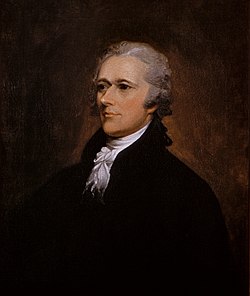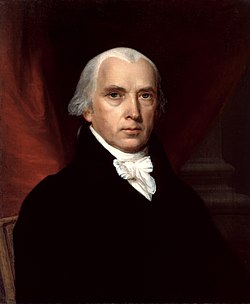Federalism
Fisher Ames (1758–1808) of Massachusetts ranks as one of the more influential figures of his era. [67] Ames led Federalist ranks in the House of Representatives. His acceptance of the Bill of Rights garnered support in Massachusetts for the new Constitution. His greatest fame came as an orator who defined the principles of the Federalist Party and the follies of the Republicans. Ames offered one of the first great speeches in American Congressional history when he spoke in favor of the Jay Treaty. Ames was part of Hamilton's faction and cautioned against the excesses of democracy unfettered by morals and reason: "Popular reason does not always know how to act right, nor does it always act right when it knows". [68] He warned his countrymen of the dangers of flattering demagogues, who incite dis-union and lead their country into bondage: "Our country is too big for union, too sordid for patriotism, too democratic for liberty. What is to become of it, He who made it best knows. Its vice will govern it, by practising upon its folly. This is ordained for democracies". [69]
Intellectually, Federalists were profoundly devoted to liberty. As Samuel Eliot Morison explained, they believed that liberty is inseparable from union, that men are essentially unequal, that vox populi ("voice of the people") is seldom if ever vox Dei ("the voice of God") and that sinister outside influences are busy undermining American integrity. [70] British historian Patrick Allitt concludes that Federalists promoted many positions that would form the baseline for later American conservatism, including the rule of law under the Constitution, republican government, peaceful change through elections, stable national finances, credible and active diplomacy and protection of wealth. [71]
In terms of "classical conservatism", the Federalists had no truck with European-style aristocracy, monarchy, or established religion. Historian John P. Diggins says: "Thanks to the framers, American conservatism began on a genuinely lofty plane. James Madison, Alexander Hamilton, John Marshall, John Jay, James Wilson, and, above all, John Adams aspired to create a republic in which the values so precious to conservatives might flourish: harmony, stability, virtue, reverence, veneration, loyalty, self-discipline, and moderation. This was classical conservatism in its most authentic expression". [5]
Federalists led the successful battles to abolish the international slave trade in New York City and the battle to abolish slavery in the state of New York. [72] The Federalists' approach to nationalism was coined "open" nationalism in that it creates space for minority groups to have a voice in government. Many Federalists also created space for women to have a significant political role, which was not evident on the Democratic-Republican side. [73]
The Federalists were dominated by businessmen and merchants in the major cities who supported a strong national government. The party was closely linked to the modernizing, urbanizing, financial policies of Alexander Hamilton. These policies included the funding of the national debt and also assumption of state debts incurred during the Revolutionary War, the incorporation of a national Bank of the United States, the support of manufactures and industrial development, and the use of a tariff to fund the Treasury. While it has long been accepted that commercial groups are in support of the Federalists and agrarian groups are in support of the Democratic-Republicans, recent studies have shown that support for Federalists was also evident in agrarian groups. [74] In foreign affairs, the Federalists opposed the French Revolution, engaged in the "Quasi War" (an undeclared naval war) with France in 1798–99, sought good relations with Britain and sought a strong army and navy. Ideologically, the controversy between Democratic-Republicans and Federalists stemmed from a difference of principle and style. In terms of style, the Federalists feared mob rule, thought an educated elite should represent the general populace in national governance and favored national power over state power. Democratic-Republicans distrusted Britain, bankers, merchants and did not want a powerful national government. The Federalists, notably Hamilton, were distrustful of "the people", the French and the Republicans. [75] In the end, the nation synthesized the two positions, adopting representative democracy and a strong nation state. Just as importantly, American politics by the 1820s accepted the two-party system whereby rival parties stake their claims before the electorate and the winner takes control of majority in state legislatures and the Congress and gains governorships and the presidency.
As time went on, the Federalists lost appeal with the average voter and were generally not equal to the tasks of party organization; hence they grew steadily weaker as the political triumphs of the Democratic-Republican Party grew. [76] For economic and philosophical reasons, the Federalists tended to be pro-British—the United States engaged in more trade with Great Britain than with any other country—and vociferously opposed Jefferson's Embargo Act of 1807 and the seemingly deliberate provocation of war with Britain by the Madison Administration. During "Mr. Madison's War", as they called it, the Federalists made a temporary comeback. [77] However, they lost all their gains and more during the patriotic euphoria that followed the war. The membership was aging rapidly, [78] but a few young men from New England did join the cause, most notably Daniel Webster.
After 1816, the Federalists had no national power base apart from John Marshall's Supreme Court. They had some local support in New England, New York, eastern Pennsylvania, Maryland and Delaware. After the collapse of the Federalist Party in the course of the 1824 presidential election, most surviving Federalists (including Daniel Webster) joined former Democratic-Republicans like Henry Clay to form the National Republican Party, which was soon combined with other anti-Jackson groups to form the Whig Party in 1833. By then, nearly all remaining Federalists joined the Whigs. However, some former Federalists like James Buchanan, Louis McLane and Roger B. Taney became Jacksonian Democrats. [79]
The "Old Republicans", led by John Randolph of Roanoke, refused to form a coalition with the Federalists and instead set up a separate opposition since Jefferson, Madison, Gallatin, Monroe, John C. Calhoun and Clay had in effect adopted Federalist principles of implied powers to purchase the Louisiana Territory and after the failures and lessons of the War of 1812 raised tariffs to protect factories, chartered the Second National Bank, promoted a strong army and navy and promoted internal improvements. All these measures were opposed to the strict construction of the Constitution, which was the formal basis of the Democratic-Republicans, but the drift of the party to support them could not be checked. It was aided by the Supreme Court, whose influence under John Marshall as a nationalizing factor now first became apparent. The whole change reconciled the Federalists to their absorption into the Democratic-Republican Party. Indeed, they claimed, with considerable show of justice, that the absorption was in the other direction: that the Democratic-Republicans had recanted and that the "Washington-Monroe policy", as they termed it after 1820, was all that Federalists had ever desired. [80]
The name "Federalist" came increasingly to be used in political rhetoric as a term of abuse and was denied by the Whigs, who pointed out that their leader Henry Clay was the Democratic-Republican Party leader in Congress during the 1810s. [81]
The Federalists had a weak base in the South, with their main base in the Northeast and especially New England, although there were some prominent southern Federalists like Charles Cotesworth Pinckney, who had been supported by Hamilton in the presidential election of 1800.
Slavery
While some Federalists advocated strategic support for the Haitian Revolution, the Federalist press strongly condemned Gabriel's Rebellion during the acrimonious presidential campaign of 1800 and claimed that "Jefferson would liberate all Negroes if elected." [86] Prominent southern Federalists, including John Marshall, Thomas Pinckney, Charles Cotesworth Pinckney, and Edward Rutledge, were slaveholders. Charles Cotesworth Pinckney successfully defended slavery at the Constitutional Convention and led the Federalist Party in the elections of 1804 and 1808. New York prior to 1799 and New Jersey prior to 1804 were slave states as well, and several leading northern Federalists from these states owned slaves, including John Jay and Philip Schuyler. Federalists supported the Fugitive Slave Act of 1793's nearly unanimous passage through Congress, and the Federalist-aligned administration of George Washington signed the bill into law. [87]
After 1800, as their political base contracted to New England, Federalists were increasingly opposed to slavery, both on principle and because the Three-fifths Compromise gave a political advantage to their opponents, who gained increased representation because of the weight given to disenfranchised enslaved people. Rufus King was a prominent opponent of slavery and became the final Federalist presidential candidate in 1816. [88]
Recent scholarship has laid increasing emphasis on later Federalist opposition to slavery [89] Day [90] states
- The Federalist Party is currently undergoing a renaissance among historians of the early Republic. This development is based largely on their occasional criticism of slavery. As the Democratic Republicans' stock has fallen in response to rising concerns over their leader Thomas Jefferson's racial views and deep entanglement with slavery, the Federalists who denounced Jefferson, the Republicans, and democracy itself have begun to look much better in comparison. While it has long been known that certain Federalist leaders—notably Alexander Hamilton and John Jay—opposed slavery and that attacks on slaveholding Virginia nabobs were part of the Federalist rhetorical arsenal after 1800, recent historians have found new significance in these facts.
However, Day argues that concerns about the political weight of the slaveholding states were more significant than moral opposition to slavery.







